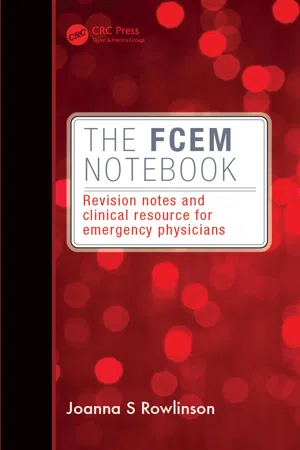
eBook - ePub
The FCEM Notebook
Revision notes and clinical resource for emergency physicians
This is a test
- 174 pages
- English
- ePUB (mobile friendly)
- Available on iOS & Android
eBook - ePub
Book details
Book preview
Table of contents
Citations
About This Book
The FCEM Notebook: Revision Notes and Clinical Resource for Emergency Physicians is the essential guide to passing the Fellowship of the College of Emergency Medicine (FCEM) examination. The book contains short questions related to the FCEM curriculum along with succinct answers to allow candidates to test their knowledge. Also included are current
Frequently asked questions
At the moment all of our mobile-responsive ePub books are available to download via the app. Most of our PDFs are also available to download and we're working on making the final remaining ones downloadable now. Learn more here.
Both plans give you full access to the library and all of Perlego’s features. The only differences are the price and subscription period: With the annual plan you’ll save around 30% compared to 12 months on the monthly plan.
We are an online textbook subscription service, where you can get access to an entire online library for less than the price of a single book per month. With over 1 million books across 1000+ topics, we’ve got you covered! Learn more here.
Look out for the read-aloud symbol on your next book to see if you can listen to it. The read-aloud tool reads text aloud for you, highlighting the text as it is being read. You can pause it, speed it up and slow it down. Learn more here.
Yes, you can access The FCEM Notebook by Joanna Rowlinson in PDF and/or ePUB format, as well as other popular books in Medicine & Medical Theory, Practice & Reference. We have over one million books available in our catalogue for you to explore.
Information
MUSCULOSKELETAL AND INJURY
What are the clinical findings in necrotizing fasciitis?
NECROTIZING FASCIITIS
Rapidly spreading infection of the fascia with necrosis.
Clinical features
Significant disproportionate/unexplained pain
Pain beyond margins of erythema
Swelling
Crepitus
Erythema, later purple/dusky skin discolouration
Lethargy
Pyrexia, hypotension, tachycardia
Bullae, later become haemorrhagic
Minor skin changes initially with later rapidly spreading skin changes
Offensive discharge
Skin necrosis
Anaesthesia of affected area
Lack of bleeding from deep tissues
Risk factors/associations
Diabetes | Chronic renal failure |
Alcohol excess | Malignancy |
Sea swimming | Chronic liver disease |
Immunocompromised | IV drug misuse |
Insect bites/stings | Minor skin trauma |
Post op surgical wounds/invasive procedure/minor procedures |
Investigation
Initially a clinical diagnosis, with surgical exploration required to confirm.
Blood cultures, blood gas, clotting screen, U&E, albumin, LFT, CRP, ESR, CK, calcium, wound swabs, cross-match blood
XR and CT may show air in soft tissues and demonstrate extent
Management
Fluid resuscitation
Antibiotics, liaise with microbiology, e.g. benzylpenicillin, clindamycin and metronidazole
Analgesia
Aggressive, prompt extensive surgical debridement
Admit to intensive care unit
Organisms
There are often mixed anaerobic and aerobic bacteria. Organisms include:
Group A streptococcus | Staphylococcus aureus |
Streptococci | Clostridium perfringens |
Coliforms | Proteus |
Pseudomonas | Klebsiella |
NOTES:
The initial skin wound can be minimal with limited skin findings and the patient appearing well, followed by a rapid deterioration and high mortality rate. Commonly misdiagnosed initially as cellulitis.
Describe the features of Kanavel sign and the significance of this sign
Give the causes of a radial nerve palsy
Give the causes of a radial nerve palsy
KANAVEL SIGN
Four components
Finger is held in slight flexion
Fusiform swelling of the finger (‘sausage-shaped finger’)
Tenderness along the course of the flexor tendon sheath
Pain on passive extension of the finger
Clinical features are found in infection of a flexor tendon sheath in the hand.
Infection usually occurs following a bite or a puncture wound. Early recognition is essential to prevent tendon scarring and loss of function. Patients require IV antibiotics, analgesia and referral for urgent incision and drainage of the flexor tendon sheath.
CAUSES OF RADIAL NERVE PALSY
Compression in axilla ‘crutch palsy’
Compression of upper medial humerus – ‘Saturday night palsy’
Humeral fracture
Elbow dislocation
Compression at wrist from tight handcuffs or watch strap
Upper arm injections in infants
What are the features of a tetanus-prone wound?
What is the UK tetanus immunization schedule?
Describe the clinical findings in tetanus
What is the UK tetanus immunization schedule?
Describe the clinical findings in tetanus
TETANUS
Tetanus-prone wounds
Wounds or burns that require surgical intervention that is delayed for more than six hours
Wounds or burns that show a significant degree of devitalized tissue or a puncture-type injury, particularly where there has been contact with soil or manure
Wounds containing foreign bodies
Compound fractures
Wounds or burns in patients who have systemic sepsis
Higher risk
Injecting drug users (tetanus-contaminated illicit drugs, especially through pre-existing skin abscesses)
Heavy contamination with material likely to contain tetanus spores (manure, soil)
Extensive devitalized tissue
UK TETANUS IMMUNIZATION PROGRAMME
Immunization given at two months, three months, four months, four years, 14 years.
CLINICAL FINDINGS IN TETANUS
Hypertonia
Painful muscular contractions, especially face (risus sardonicus), jaw (lock-jaw), back (opisthotonus), neck
Generalized mu...
Table of contents
- Cover
- Half Title
- Title Page
- Copyright Page
- Dedication
- Table of Contents
- Preface
- Abbreviations
- CARDIOLOGY
- DERMATOLOGY
- ENDOCRINOLOGY
- ENVIRONMENTAL MEDICINE
- GASTROENTEROLOGY
- HAEMATOLOGY
- INFECTIOUS DISEASES
- MEDICOLEGAL
- MUSCULOSKELETAL AND INJURY
- NEUROLOGY
- OBSTETRICS AND GYNAECOLOGY
- OPHTHALMOLOGY
- PSYCHIATRY
- RESPIRATORY
- SAFEGUARDING
- SPINAL
- TOXICOLOGY